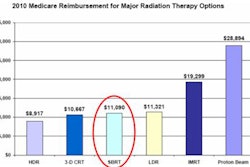A large-scale audit of women treated throughout the U.K. for cervical cancer in 2001 and 2002 has reconfirmed that the combination of radiation therapy and chemotherapy is more effective than radiation therapy alone, according to findings published in the September issue of Clinical Oncology.
Patients who received the combined treatment had an 11% greater overall survival rate than patients who only received radiation therapy. The audit confirms the appropriateness of a clinical alert issued by the National Cancer Institute (NCI) of the U.S. National Institutes of Health in February 1999 recommending that platinum-based chemotherapy be administered concurrently with radiation therapy for cervical cancer patients. The Royal College of Radiologists of London sponsored the audit (Clinical Oncology, September 2010, Vol. 22:7, pp. 590-601).
Data were supplied by 42 healthcare treatment centers for 1,243 cervical cancer patients treated during the 24-month time frame. Reporting centers included 33 in England, three in Scotland, and two in Wales. One center in Northern Ireland also provided data, which were included in the study.
After excluding patients who had nonradical treatment and those with insufficient data, data from a total of 1,075 women followed for a median of 5.2 years were analyzed. Patients were categorized by subgroup of treatment:
- Radical radiation therapy: at least 40-Gy external-beam radiation therapy plus brachytherapy or greater than 50-Gy external-beam radiation therapy with no brachytherapy
- Radical chemoradiotherapy: radical radiation therapy plus any concurrent chemotherapy treatment
- Surgery plus postoperative radiation therapy or chemoradiotherapy
At five years following treatment, the overall survival rate was 71% for patients who had surgery with postoperative radiation therapy, 55% for patients who had radical chemoradiotherapy, and 44% for patients who had radical radiation therapy. Disease-specific survival at five years was 76%, 59%, and 54%, respectively.
The effectiveness of chemoradiotherapy compared to radiation therapy alone was also compared by stage of cancer:
|
||||||||||||||||||||||||||||
Approximately 20% of the total group had local recurrence, and approximately 20% developed distant metastases located primarily in the lymph nodes, lung, liver, and bone. Independent prognostic factors for local recurrence were the stage of cancer and nodal involvement. Patients who developed distant metastases also had involvement of the pelvic nodes, but other independent prognostic factors included a high dose rate of brachytherapy and the size of the medical center where they were treated.
Lead investigator Paul Symonds, MD, of the department of cancer studies and molecular medicine of Leicester Royal Infirmary in Leicester, U.K., and colleagues expressed their surprise that treatment type could not be identified as an independent prognostic factor. The authors may have been able to do so if they had had complete data for each patient, they noted. Due to missing data or lack of detailed data, the numbers of patients for each type of statistical analysis varied.
The research team reported a grade 3 or 4 late complication rate of 8%, noting that complications continued to develop up to seven years. No differences in complication rates could be identified between the chemoradiotherapy and radiation therapy treatments. However, in the radiation therapy group, the majority of late bowel and bladder complications occurred within the first three years of treatment.
An accompanying editorial by Claire Vale and Jayne Tierney, staff members of the Meta-Analysis Group of the Medical Research Council (MRC) Clinical Trials Unit in London who participated in the audit, expressed concern that both mild and acute complications were not and are not being adequately evaluated. They emphasized that even side effects graded clinically as being "mild" or "moderate" affect day-to-day life. Patients may be affected psychologically and sexually.
Because there is no mechanism of referral to sexual counselors for these patients, and because women are often reticent about discussing potentially embarrassing issues relating to sexual function and bowel incontinences, the authors suggested that late toxicities may be seriously underreported.
"Cervical cancer trials of any treatment modality ought to collect data on the late effects of treatment and quality of life, specifically how treatment affects the bladder, bowel, vagina, and sexual function," the authors wrote. "If treatments are found to be equivalent in terms of survival, this information will become increasingly important."
They emphasized that clinical trials must include the collection, analysis, and reporting of late complications; they pointed out that these treatments could save a patient's life but also restrict or devastate her quality of life. When a choice of treatment is available, cervical cancer patients need to be given accurate information about late toxicity risks as much as survival risks.
Li Tee Tan, MD, a radiation oncologist at the oncology center of Addenbrooke's Hospital in Cambridge, also expressed concern about the level of complications reported in the audit. In an editorial that accompanied the study, Tan observed that the audit reported no difference in the crude rates of serious late toxicity for patients treated with chemoradiotherapy (10%) compared to radiation therapy alone (8%). However, there were six treatment-related deaths in the chemoradiotherapy group compared with no deaths from radiation therapy alone.
A national cervical cancer database for prospective data collection is urgently needed, according to Tan. She pointed out that there was overwhelming support to establish such a database from delegates representing 29 cancer treatment centers, who attended a national meeting on the use of image-guided brachytherapy for cervical cancer.
"The need for objective evidence of clinical benefit is greater than ever in the current financial climate if radiation therapy departments are to persuade trust boards and healthcare commissioners to invest in highly expensive equipment," Tan wrote.
By Cynthia E. Keen
AuntMinnie.com staff writer
August 27, 2010
Related Reading
Vaginal dilation does not prevent damage from radiotherapy, March 11, 2010
Cervical cancer RT causes pelvic fractures, study suggests, February 2, 2010
More intense hyperthermia better treats cervical cancer, July 15, 2009
Toxicity levels with gynecologic chemoradiation deemed acceptable, November 28, 2007
Triple modality approach effective against cervical cancer, August 31, 2005
Copyright © 2010 AuntMinnie.com




_p888_f1_thumb.png?auto=format%2Ccompress&fit=crop&h=167&q=70&w=250)














